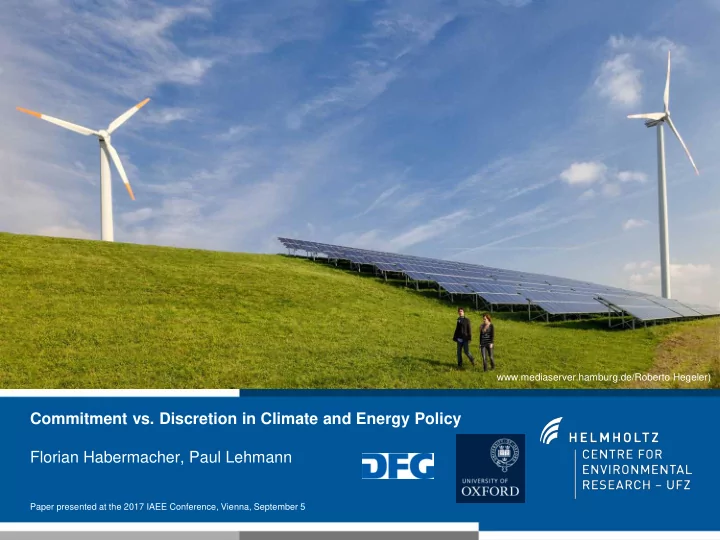

www.mediaserver.hamburg.de/Roberto Hegeler) Commitment vs. Discretion in Climate and Energy Policy Florian Habermacher, Paul Lehmann Paper presented at the 2017 IAEE Conference, Vienna, September 5
Outline Introduction Model Results Conclusion SEITE 2
RES policy commitment and discretion in Europe Tariff level index (year of implementation = 100) Evolution of feed-in tariffs for newly installed onshore wind power in selected European countries SEITE 3
Trade-off for climate and energy policy Costs of discretion Costs of commitment Time-inconsistent policy- Benefits and costs of RES making if policy-makers depoyment uncertain ex ante simultaneously aim at Commitment foregoes promoting RES deployment opportunity to incorporate new and limiting costs of RES knowledge in RES policy deployment design Result: under-investment in Result: over- or under- RES deployment today investment in RES deployment in the future Research question: How does this trade-off affect the optimal intertemporal design of policies to support RES deployment? SEITE 4
Linking two strands of literature Optimal choice of environmental policy in the presence of irreversible investments and time-inconsistant policy-making (uncertainty in benefits or costs largely ignored) (Biglaiser et al.,1995; Marsiliani and Renström, 2000; Abrego and Perroni, 2002; Helm et al., 2003, 2004; Levine et al., 2005; Baldursson and von der Fehr, 2008; Ulph and Ulph, 2013) Optimal timing and choice of environmental policy with uncertain policy benefits and/or costs (time inconsistency largely ignored) (Weitzman, 1974; Roberts and Spence, 1976; Stavins, 1996; Pindyck, 2000, 2002; Pizer, 2002; Jacoby and Ellerman, 2004) SEITE 5
Outline Introduction Model Results Conclusion SEITE 6
Dynamic partial equilibrium model A representative firm invests in RES deployment in period 1 and 2, investments are irreversible and last for two periods External benefits and technology costs of RES deployment may be uncertain with two possible states RES subsidy to internalize external benefit; produces deadweight loss due to distortionary taxes levied to fund the subsidy (= trigger for time-inconsistent policy-making in the case of discretion) Policy scenarios: Unconditional commitment in Discretion to set a subsidy rate period 1 to a fixed subsidy rate 𝑡 2 𝑡 2𝑗 in period 2 after learning about the firm’s investment in period 1 for period-2 investments and the actual state of the uncertain parameter in period 2 SEITE 7
Outline Introduction Model Results Conclusion SEITE 8
Ambiguous choice between unconditional commitment and discretion if benefits uncertain Choice between unconditional commitment (UC) and discretion (UN) is analytically ambiguous: 2 𝑚 2 𝑐 1 + 𝐹 𝑐 2 𝜀 + 1 + 𝑚 𝑤 1 + 𝜀 2 1 𝜀𝑑 2 2 1 + 𝜀 2 𝑋 𝑉𝐷 − 𝑋 𝑉𝑂 = − 𝑑 1 𝜏 𝑐 1 + 𝜀 2 + 𝑚 2 4 + 9𝜀 + 4𝜀 2 2𝑑 1 𝑑 2 1 + 2𝑚 1 + 4𝑚 Pro commitment: Cost of discretion increases in consumer benefits ( 𝑤 ) and (expected) external benefits ( 𝑐 1 , 𝐹[𝑐 2 ] ) Pro discretion: Cost of commitment increases in the variance of 2 ), cost of discretion decreases in the degree of external benefits ( 𝜏 𝑐 exogenous technological progress ( 𝑑 1 − 𝑑 2 ) Ambiguous effects of deadweight loss ( 𝑚 ) and discount factor ( 𝜀 ) SEITE 9
Numerical illustration – Main scenario 1 Period = 10 years Parameter Value Unit Interpretation 𝜀 0.631 4.5% annual discount rate 𝑤 bn € /GW Wholesale electricity price 30 € /MWh 0.53 𝑑 1 bn € /(GW) 2 70 € /MWh capex for 200th GW of wind power 0.0082 𝑑 2 bn € /(GW) 2 50 € /MWh capex for 200th GW of wind power 0.0053 𝑚 30% deadweight loss per € raised by taxation 0.3 𝑐 1 , 𝑐 2 , 𝐹[𝑐 2 ] bn € /GW 70 € /tCO 2 0.92 𝑐 2𝑀 bn € /GW 0.66 +/- 20 € /tCO 2 , 𝛽 =0.5 𝑐 2𝐼 bn€/GW 1.18 SEITE 10
First naïve finding: Discretion outperforms unconditional commitment in the main scenario Welfare in bn € Discretion, 𝑋 521.7 𝑉𝑂 Unconditional commitment, 𝑋 516.2 𝑉𝐷 Discretion superior to unconditional commitment: Costs of commitment dominate costs of discretion But: Welfare differences relatively small Degree of commitment across time may be less important than choosing the adequate ambition for RES support today Sensitivity of results? Relatively robust SEITE 11
But: More realistic model assumptions put commitment at an advantage Commitment becomes (more) favorable if (1) uncertainty resolves only slowly (see figure) , (2) future policy-makers are not benevolent, and/or (3) investors are risk-averse. Welfare difference between commitment 𝑿 𝑽𝑫 and discretion 𝑿 𝑽𝑶 : Sensitivity to deadweight loss 𝒎 and standard deviation of the benefit resolving over time 𝝉 𝒄 (yellow plain shows the zero level) SEITE 12
Comparison of social welfare if RES technology costs uncertain If subsidy is to internalize external benefits: commitment > discretion (because optimal Pigouvian subsidy rate independent of costs) If subsidy is to attain politically set RES target : discretion > commitment (because target impedes discretion if policy-makers commit to it credibly) SEITE 13
Outline Introduction Model Results Conclusion SEITE 14
Conclusions High degree of RES policy commitment may be economically sensible , despite uncertain benefits and costs of RES deployment Important exception: RES subsidy discretion may be economically sensible in the presence of a credibly binding RES target Similar conclusions may apply to climate policy in general once the level of ambition of carbon pricing has risen Small welfare differential between commitment and discretion suggests choosing an adequate ambition for climate and energy policy today is more important than the way policy makers commit to it across time . SEITE 15
Thank you for your attention! Preliminary version published as: CESifo Working Paper 6355 Contact: paul.lehmann@ufz.de www.ufz.de/energyeconomics www.mediaserver.hamburg.de/Roberto Hegeler) SEITE 16
Recommend
More recommend